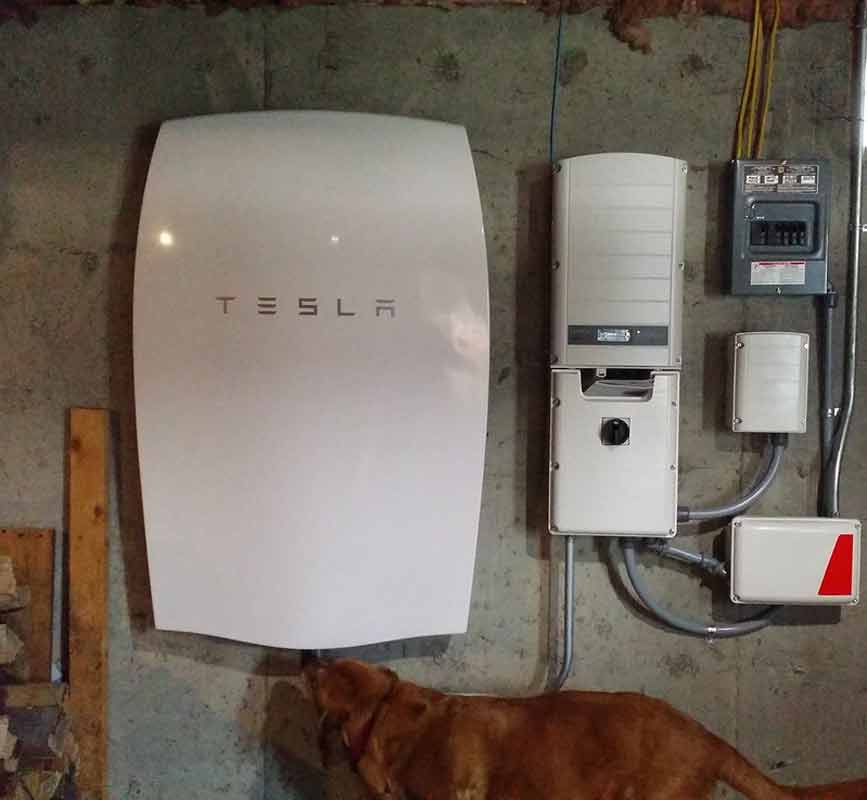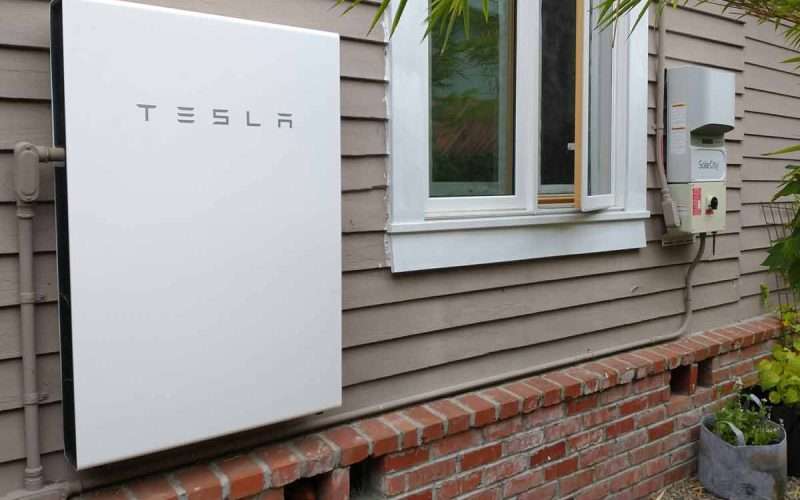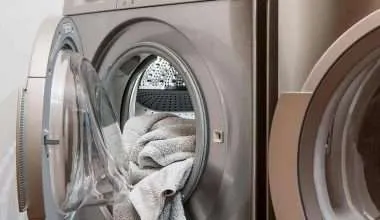Table of Contents Show
What is the Tesla Powerwall?
In 2015, Tesla introduced its lithium-ion battery which stored energy generated by Tesla’s solar panels. These batteries were also charged through electricity if someone wished to use them as a backup option.
As many as 10 Powerwall units can operate together as a single energy storage system, so it makes them a great energy storage solution. One can conveniently use it at their home or even at their business place where they have a solar roof
Tesla has discontinued its model Powerwall 1 since 2016. Powerwall 2 and Powerwall + are now available for buying. The company has updated these new versions. They work better than ever. The updated version’s single battery unit can store 13.5 kilowatt-hours of power. Whereas, the old version only stored 6.4 kWh.
These new versions also give a higher output than the old ones. Also, they provide electricity to one or more devices at the same time.
Powerwall + has an extra specification which is that it has an inverter that makes integration with solar panels easier. Plus, when there is a full sun, Powerwall + can deliver more kilowatts while Powerwall 2 has no extra impact of sunlight on it.
Features of the Tesla Powerwall
1. Battery Capacity
Tesla has two models, Powerwall 2 and Powerwall +. Both of them have a 13.5 kWh stored energy capacity. However, their capability depends on the amount of direct sunlight (solar energy) that panels receive in a day.
The systems can provide a full-day battery as a backup during the winter or on a cloudy day. The capacity can extend to 2.5 days during summer. If you install two batteries, the capacity can increase during a cloudy season. It can even cover 7 days or more if solar panels get full exposure.
Though it is possible to add up to 10 batteries to your home energy system, two batteries are more than enough to meet normal home energy needs.
2. Chemistry
As mentioned above, the Tesla Powerwall is a solar battery. It has a lithium-ion structure that uses lithium nickel manganese cobalt oxide (NMC) chemistry. These batteries are the most common type of solar batteries.
The life span of these batteries is 10-12 years, and they have a high energy storage capacity. Despite being small-sized batteries, they can store a good amount of energy.
3. Depth of Discharge
You can charge and recharge the solar batteries but this drains their battery and thus, affects their efficiency. The depth of discharge calculates the amount of power that you can draw from a battery before it affects its lifespan.
Many battery manufacturers limit the depth of discharge to preserve the battery life. The standard of the industry is between 80% and 100%. Both the models of a Powerwall have 100% Depth of Discharge. This means you can charge the battery to its full capacity every time.
4. Power Output
The output of both Tesla models depends on the weather conditions. Powerwall 2 provides 5.8 kW of continuous power and 10 kW of peak power. Powerwall + can provide the same amount of power even if there is no sun.
However, when in the sun, it can produce much more power; 7.6 kW steady power and 22 kW peak power.
The ongoing continuous power measures the amount of power that can be released from a solar battery in a certain period. Typically, batteries run at a lower capacity to provide power for a longer time.
While peak power calculates the highest burst of energy that a battery can provide. A battery that has high peak power can eject a large amount of energy in a short period.
5. Round-trip Efficiency
There is a small percentage of power that is needed to run the battery, so you will not be able to use 100% of the energy every time. The round-trip efficiency calculates the amount of electricity that is available for use after it has been fully charged.
A typical solar battery has a round-trip efficiency of 80% according to the U.S. Energy Information Administration. The Tesla Powerwall has a round-trip efficiency of 90% which makes it an above-average storage solution that is very efficient.
6. System Capability
Tesla Powerwall 2 is made to work around the existing solar systems with a third-party solar inverter. The job of the inverter is to convert the direct current power received from the sun into alternating current power usually used in homes.
Powerwall 2 can be added to any system which may use numerous inverters of different brands. There is a whole list of compatible inverters on Tesla’s website. Moreover, Powerwall + has its own inverter which suits best with the new solar system.
7. Warranty
There is a 10-year warranty for both models. Also included is a four-year workmanship warranty by Tesla. The warranty covers any repairs or replacements that might have occurred during installation.
If any part has to be shipped, the shipping charges will be covered in the warranty. It is stated by Tesla that the Powerwall will have an end-of-warranty capacity of 70% to its 13.5 kWh. The average comes around 60%.
The Warranty covers any shipped part and shipping charges. For its battery, Tesla offers a 70% end-of-warranty capacity of 13.5 kWh. This guarantees your battery will still be able to maintain 70% of its energy capacity after 10 years. The industry average comes to around 60%.
The Warranty covers any shipped part and shipping charges.
What is the Cost of Tesla Powerwall?
The cost of the Tesla Powerwall is slightly higher than other battery systems. But, with that, you get a high storage capacity and power output as well. The exact cost depends on the number of units that you order.
A single unit of Powerwall sells for $10,500, but if you get two units, it will cost you $17,000. That means two units will cost you $8,500 each. You can buy this product directly from Tesla as well as certified sellers of Tesla. There are third-party sellers and local solar installers where you can purchase this system.
Battery systems including the Powerwall qualify for the 30% federal solar tax credit. It tends to effectively decrease the price of an individual unit to $7,350 down from $10,500. One has to be eligible to qualify, the requirements are:
- The battery must function with solar panels or any other renewable energy source to get credit. So, a stand-alone unit would not qualify if it only pulls charge from the grid.
- If it is used in a home, solar panels should charge 100% of it.
- And if you are using it in a business place, 75% of it should be charged through solar panels.
Advantages of Tesla Powerwall
Out of many advantages, the biggest benefit of Powerwall is its stackable output. As it is an AC battery, additional batteries will result in more power. This means that when one powerwall output is 5kWh, two will have 10kWh output.
More batteries increase the amperage of circuits with improved backup. Here, one unit can back-up up to 30 amps, two units can back up 60 amps, etc. The DC batteries do not have a stackable output.
Moreover, if you install multiple DC batteries, they will increase the storage capacity of the system. Like the Tesla vehicles, powerwall also has a liquid heating and cooling system which runs through the battery pack. It keeps the cells operating at an ideal temperature.
The system provides long-term performance. Also, it reduces degradation and makes the powerwall flexible enough to be installed in outdoor areas exposed to high heat.

Is Powerwall Worth it?
All in all, Tesla has an excellent battery. It comes at a high price but has advanced-level features along with unique specifications. Tesla powerwall installation is a great investment and is totally worth it but it surely comes with the extra hassle.
Tesla only sells units that have new solar panel installations. This point is a huge letdown because many people find it difficult to buy one. Due to this reason, people who have already installed solar panels can not get Powerwall installed from Tesla.
Instead, they have to look for a certified seller that is willing to sell a stand-alone Tesla Powerwall battery to them. Also, keep in mind that as known from experience, Tesla has poor after-sales service. So, when you get the Tesla powerwall battery installed, you will have a hard time dealing with them.
Taking into consideration that you will have to deal with this issue for 25 years if you choose this company and get the solar installation done by them. It might take years for you to get a battery installed from Tesla!
Local installers are much better than the Tesla itself. You can talk to them and ask about solar battery recommendations. The best and easiest way is to find installers that can help you pair a solar installation with storage in your area.





